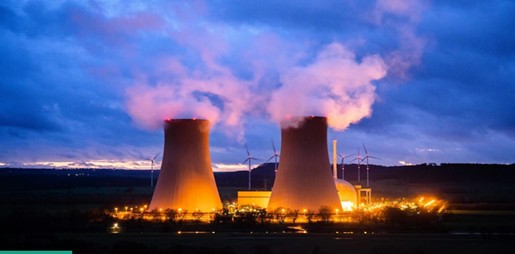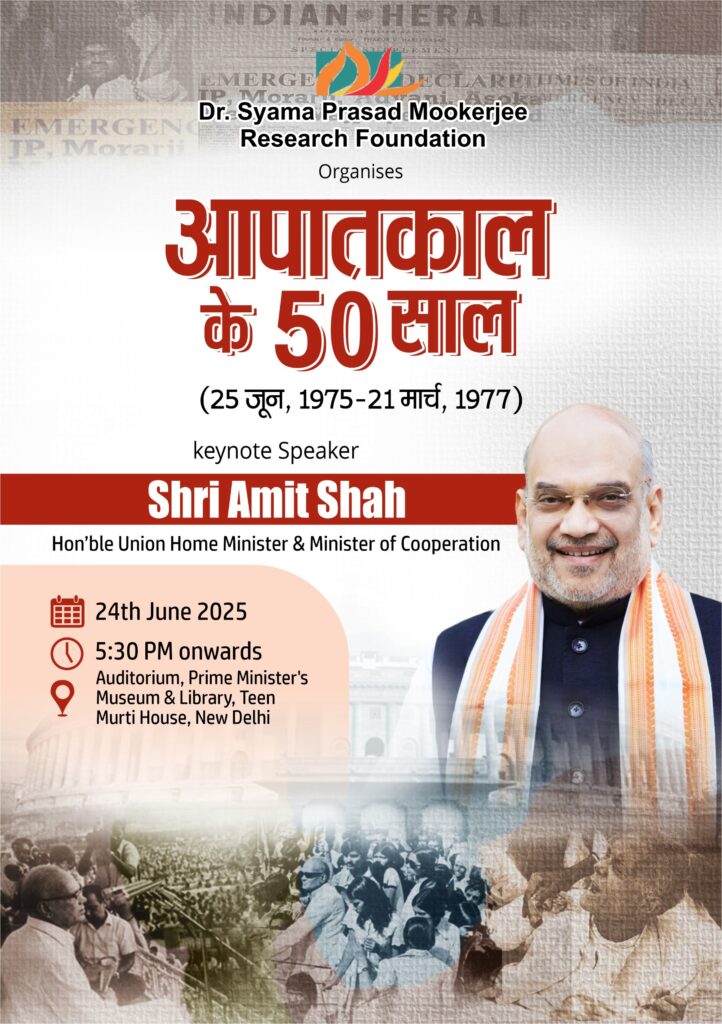Development of Bharat Small Reactors (BSRs) can serve as captive power sources for energy-intensive industries to make India a manufacturing powerhouse for 4th IR and aligns with India’s COP26 climate commitments, supporting national decarbonization goals by providing clean and sustainable energy.
Introduction Prime Minister Narendra Modi has consistently emphasized the importance of civil nuclear energy in India’s long-term development. His vision aligns with India’s ambitious goals of achieving energy security, reducing dependence on fossil fuels, and promoting sustainable development. The Union Budget 2025-26 reflects this commitment by outlining an aggressive strategy to expand nuclear power, with a target of 100 GW nuclear power capacities by 2047. This initiative is a cornerstone of Viksit Bharat, ensuring reliable, clean, and efficient energy to fuel the nation’s growth.
Nuclear Energy Mission for Viksit Bharat
Recognizing nuclear power as a critical component of India’s energy mix, the Modi government has introduced the Nuclear Energy Mission for Viksit Bharat to strengthen the country’s energy security and sustainability. This mission focuses on enhancing domestic nuclear capabilities, promoting private sector participation, and accelerating the deployment of advanced nuclear technologies, including Small Modular Reactors (SMRs). A significant step in this direction is the allocation of ₹20,000 crore in the Union Budget 2025-26 for the development of SMRs. The government aims to indigenously design and operationalize at least five SMRs by 2033, fostering innovation and advancing nuclear technology to support India’s long-term energy transition strategy.
Legislative and Policy Reforms
To enable greater private sector participation and accelerate the expansion of nuclear power, the Modi government is introducing amendments to the Atomic Energy Act and the Civil Liability for Nuclear Damage Act. These legislative reforms are aimed at removing regulatory bottlenecks, fostering investment, and creating a business-friendly environment for nuclear energy development. By amending the Atomic Energy Act, the government seeks to streamline the approval process for nuclear projects, enable technology collaborations, and encourage private enterprises to invest in nuclear power generation. Additionally, modifications to the Civil Liability for Nuclear Damage Act will ensure a balanced approach to liability concerns, making it easier for both domestic and international players to participate in India’s nuclear energy sector. These reforms will help simplify regulatory frameworks, promote innovation, and facilitate the adoption of advanced nuclear technologies such as Small Modular Reactors (SMRs).
Bharat Small Reactors (BSRs): Enhancing Energy Accessibility
A key element of the Modi government’s nuclear strategy is the development of Bharat Small Reactors (BSRs)—220 MW Pressurized Heavy Water Reactors (PHWRs) known for their proven safety and efficiency. These reactors offer multiple advantages, including reduced land requirements, making them ideal for deployment near industrial hubs where reliable power is essential. BSRs can serve as captive power sources for energy-intensive industries such as steel, aluminum, and heavy manufacturing, ensuring uninterrupted electricity supply while reducing dependency on conventional fossil fuels. Additionally, their integration aligns with India’s COP26 climate commitments, supporting national decarbonization goals by providing clean and sustainable energy. The implementation model for BSRs follows a public-private collaboration approach, where private entities will provide land, water, and capital investment, while the Nuclear Power Corporation of India Limited (NPCIL) will oversee design, quality assurance, and operations. This innovative framework is set to accelerate nuclear power expansion while maintaining the highest safety standards, reinforcing India’s commitment to energy security and sustainable industrial growth.
Bharat Small Modular Reactors (BSMRs): The Future of Nuclear Energy
India is making significant strides in Small Modular Reactors (SMRs)—advanced nuclear reactors with capacities ranging from 30 MWe to over 300 MWe. These reactors offer numerous advantages, including scalability, as their modular design allows phased expansion based on energy demand. They also provide flexibility, making them suitable for both grid-connected and off-grid applications, ensuring reliable power in diverse settings. Additionally, SMRs are cost-effective, featuring reduced construction time and lower capital investment compared to traditional nuclear plants. Their land efficiency enables deployment in remote locations and the repurposing of retiring coal-based power plants, contributing to a sustainable energy transition. India’s Bhabha Atomic Research Centre (BARC) is leading the development of indigenous SMRs, leveraging its expertise in Pressurized Heavy Water Reactors (PHWRs) to create cutting-edge nuclear solutions. This initiative aligns with India’s ambitious goal of achieving 500 GW of non-fossil fuel energy capacity by 2030, reinforcing the country’s commitment to clean energy and long-term energy security.
Expansion of Nuclear Capacity: Key Government Initiatives
India is rapidly expanding its nuclear power capacity, with the government setting an ambitious target to increase nuclear power generation from 8,180 MW to 22,480 MW by 2031-32. A major step in this direction is the construction of 10 new reactors with a combined capacity of 8,000 MW across Gujarat, Rajasthan, Tamil Nadu, Haryana, Karnataka, and Madhya Pradesh. Additionally, pre-project activities for 10 more reactors are underway, ensuring phased completion by 2031-32. Strengthening international collaboration, India is working with the USA on a 6 x 1208 MW nuclear power plant in Kovvada, Andhra Pradesh, which will significantly contribute to the nation’s clean energy goals. A key milestone in this expansion was achieving criticality in Unit-7 of the Rajasthan Atomic Power Project (RAPP-7) in September 2024, marking another step toward increasing operational capacity. These developments reaffirm India’s commitment to nuclear energy as a sustainable, scalable, and secure power source, essential for meeting the country’s growing energy demands while supporting its climate commitments.
Recent Developments in Nuclear Energy
India has made significant progress in nuclear energy production and infrastructure development, strengthening its position as a leader in clean and sustainable power generation. The discovery of new uranium deposits at Jaduguda Mines has extended the mine’s life by 50 years, ensuring a steady supply of nuclear fuel for future expansion. In a major milestone, two indigenous 700 MWe Pressurized Heavy Water Reactors (PHWRs) at Kakrapar, Gujarat (KAPS-3 & 4) became operational in FY 2023-24, enhancing India’s domestic nuclear power generation capacity. Further advancing its technological capabilities, India is making rapid strides in closed fuel cycle technology with the 500 MWe Prototype Fast Breeder Reactor (PFBR), marking a significant leap toward more efficient and sustainable nuclear energy. To accelerate the expansion of nuclear power, the government has established ASHVINI, a joint venture between Nuclear Power Corporation of India Limited (NPCIL) and NTPC, to build and operate nuclear power plants, ensuring greater collaboration and efficiency in the sector. These developments reflect India’s commitment to achieving energy security and sustainability through nuclear power.
Ensuring Safety and Sustainability
India’s nuclear power plants operate under stringent safety protocols, maintaining radiation levels well below global benchmarks to ensure public and environmental safety. The country’s robust regulatory framework emphasizes strict adherence to international nuclear safety standards, reinforcing confidence in its nuclear energy program. Advanced reactor designs, rigorous quality controls, and continuous monitoring contribute to sustainable and secure energy generation. By prioritizing safety and technological excellence, India is strengthening its position as a responsible nuclear power, ensuring long-term reliability and environmental protection in its expanding nuclear infrastructure.
The Union Budget 2025-26 marks a transformative shift in India’s energy landscape, with nuclear power positioned as a crucial driver of both economic and environmental sustainability. Through initiatives such as the Nuclear Energy Mission for Viksit Bharat, the development of Bharat Small Reactors (BSRs), and the promotion of Bharat Small Modular Reactors (BSMRs), India is laying the foundation to emerge as a global leader in nuclear technology by 2047. These strategic actions are aligned with the country’s broader vision of Viksit Bharat, aimed at achieving self-reliance in clean energy solutions. By prioritizing nuclear power, India is not only ensuring energy security for the future but also making substantial progress towards achieving its long-term goals of environmental sustainability, carbon neutrality, and energy independence. With a focus on innovation, private sector participation, and advanced nuclear technologies, these efforts will contribute significantly to India’s transformation into a developed and energy-secure nation.
(The views expressed are the author's own and do not necessarily reflect the position of the organisation)



